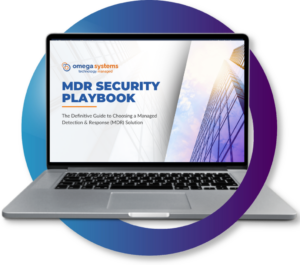When selecting an MDR (managed detection & response) security provider, you’re looking for more than just a vendor – you need a partner who can act as your de facto security team. Choosing an MDR provider involves balancing upfront costs with long-term value – ensuring that the services and expertise you pay for will ultimately save you money by preventing incidents and minimizing downtime.
This guide highlights key factors to consider, helping you choose a provider that aligns with your unique needs and delivers long-term value.
How to Assess the Right MDR Provider for Your Needs
In the article “Key Components of MDR & Why Every Business Needs It,” we explored the essential technologies that form the backbone of an effective managed detection & response service, such as SIEM, SOAR, SOC, and other advanced capabilities – all of which are crucial for continuously monitoring, detecting, and responding to threats in real time.
However, technology alone isn’t enough to guarantee success. Your MDR provider’s expertise, service delivery model, and alignment with your business objectives are just as important to ensuring a successful and long-lasting partnership.
To choose the right MDR provider, consider the following fundamentals:
Security Expertise & Services
When assessing an MDR provider, prioritize their expertise in cybersecurity. You need a partner whose team can skillfully detect, respond to, and mitigate threats using cutting-edge tools and methods.
- Analyst Expertise: Your MDR provider should boast a team of highly skilled and experienced security analysts with deep knowledge across threat intelligence, incident response, digital forensics, and general security best practices.
- Incident Response Team: A round-the-clock incident response (IR) team with experience maneuvering against various threat vectors through multiple IR methodologies is key to effective response and recovery when a threat does slip through.
- Threat Hunting: Ensure your security provider utilizes proactive threat hunting capabilities with skilled analysts and advanced tools to uncover hidden threats in your environment.
- Vulnerability Management: You’ll need comprehensive vulnerability management services, including assessment, prioritization, and remediation, to identify and address system weaknesses before they can be exploited.
- Compliance Support: Look for a provider who can lend additional support with industry-specific compliance regulations like HIPAA, CJIS, or PCI DSS to help you meet necessary regulatory requirements.
Service Delivery & Customer Experience
Your MDR provider’s service delivery and support structure will directly impact your experience. Ensure they are reliable, responsive, and offer clear terms that align with your operational needs.
- Service Level Agreements: Make sure you have clearly defined SLAs that outline performance metrics, response times, and resolution expectations to ensure consistent service delivery and accountability.
- Customer Support: Responsive and knowledgeable customer support, available through multiple channels including phone and email, is essential for addressing your needs and inquiries promptly. A dedicated team familiar with your business will provide more effective and tailored support.
- Professional Services: Your provider should offer a range of professional services, including implementation, integration, customization, and training, to ensure a smooth MDR adoption process. Working with a consistent team who understands your environment will enhance these services.
- Market Reputation: Choose an MDR provider with a strong market reputation. Review existing customer feedback, testimonials, case studies, and industry recognition to validate reliability and trustworthiness.
- Pricing & Contract Terms: Budgeting for security shouldn’t be a guessing game. When pricing is tied to factors like log volume, costs can skyrocket, especially during an incident when analyzing extensive data becomes necessary. Instead, opt for a provider that offers a fixed, predictable pricing model based on your attack surface, ensuring better cost control during high-activity periods.
OMEGA INSIGHT: Look beyond just the price tag – consider the long-term value of what you’re getting in terms of reduced risk, fewer incidents, enhanced compliance, and the cost savings of having a strong, proactive security posture that supports overall business resilience.
Strategic Business Alignment & Maximized ROI
Investing in MDR is about more than just technology; it’s about ensuring that your security strategy aligns with your business goals and delivers measurable returns. The right provider should justify the cost by providing more than just protection – they should enable business continuity, reduce risk, and prevent costly incidents.
- Cost vs. Employee Productivity: Savvy cyber threats can trip up even the most educated employees. A proactive MDR platform can mitigate security risks before they reach employees and negatively impact productivity, saving your business from potential productivity losses.
- Cost vs. Risk Reduction: Look for a provider who offers scalability and flexibility at a competitive rate while also reducing your risk over time. While upfront costs may seem high, the value comes from fewer breaches, less downtime, and stronger business continuity.
- Long-term ROI: The right MDR provider will be able to demonstrate measurable returns on your security investment – reduction in breach-related costs, improved compliance, and operational efficiency. Beyond avoiding the costs of incidents, an MDR provider should empower your business to grow securely, making it easier to scale without increasing risk.
- Compliance & Regulatory Costs: Compliance with industry regulations can be resource-intensive. A good MDR provider will help manage these requirements, reducing the risk of non-compliance fines and ensuring your organization meets necessary standards without incurring additional costs.
- Clear Cost-to-Benefit Analysis: Ensure that the provider can provide a detailed cost-to-benefit breakdown, showing exactly how their services will reduce risk and align with your overall business strategy.


 The Definitive Guide to Choosing an MDR Solution
The Definitive Guide to Choosing an MDR Solution